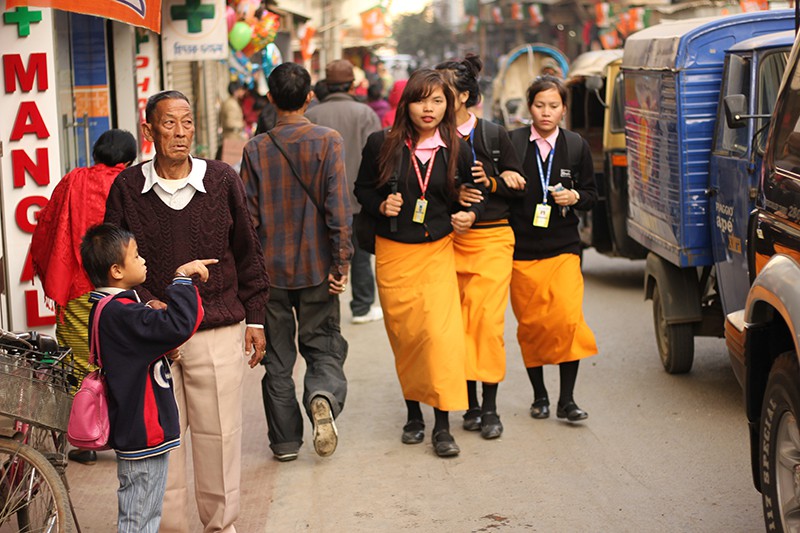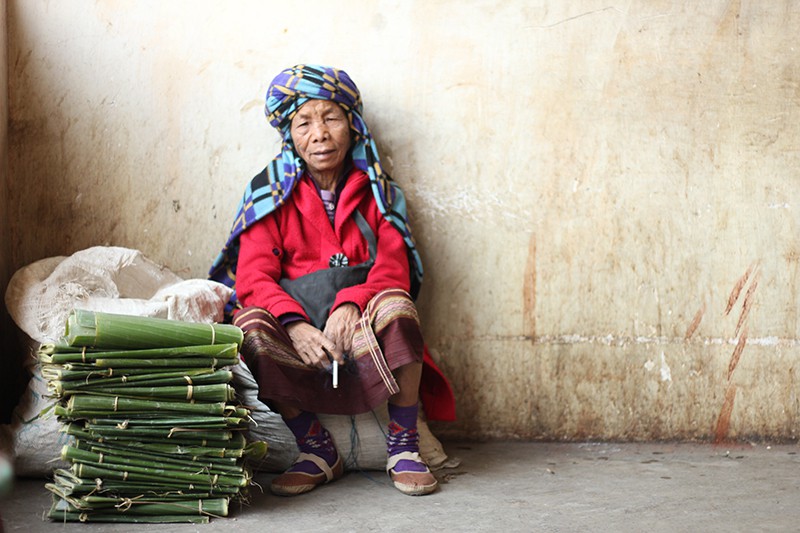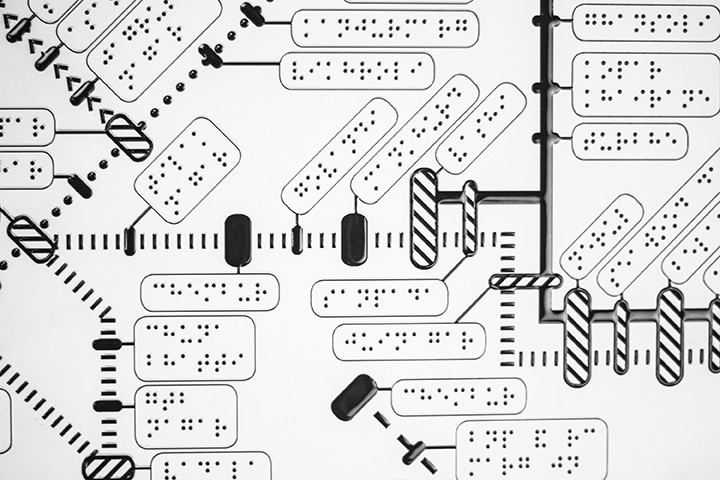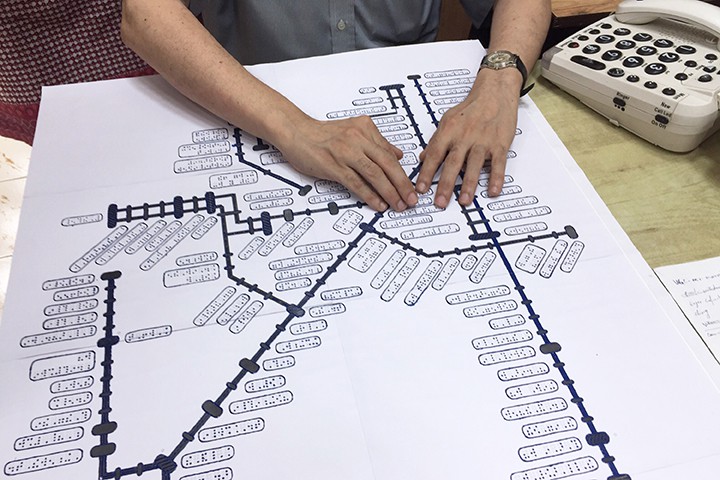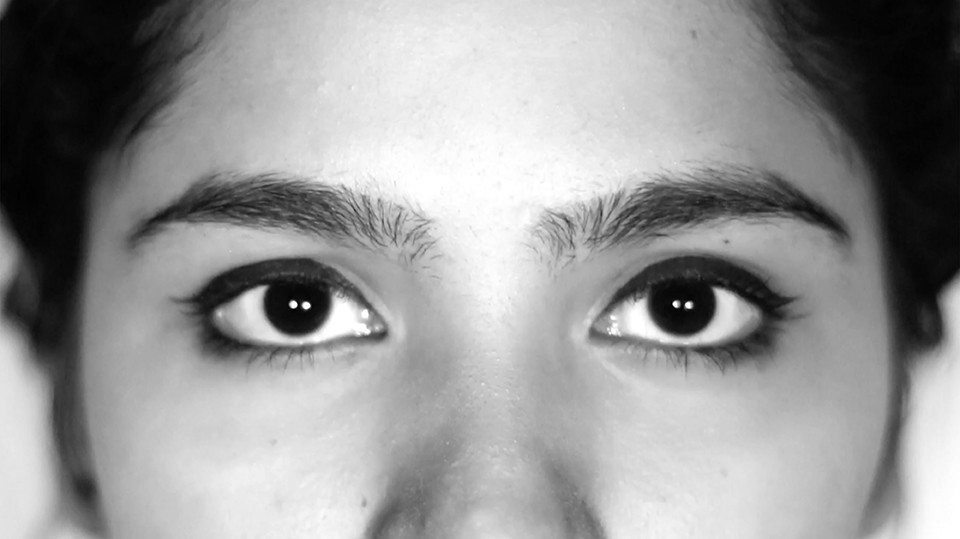Teaching Devanagari Calligraphy to Children
Guided by Prof. G V Sreekumar
This project documents a series of workshops conducted to teach children between the ages of 10 & 12 Devanagari calligraphy with the intent to sensitize them to the art of calligraphy and writing beautiful letterforms as well as generate awareness about calligraphy not just as a hobby or craft activity but also a creative process of expression.
A 3 workshop structure was created wherein activities & tasks that would aid their understanding of Devanagari and help them learn calligraphy using a structured, step-by-step process were designed. The activities begin with an introduction to basic strokes and then move on to more complex and technical aspects of calligraphy.
Designing a self-sustaining, design-centric magazine published by ID
Guided by Prof. Sudesh Balan
Magazines are a powerful tool to promote an ideology or way of thinking. However, in the current scenario, magazines are finding it difficult to sustain themselves without the support of advertisements as readership is dwindling due to the slow rise of the digital reading audience.
The aim of the project is to create a design magazine, published by IDC & targeted at young, aspiring design students, that talks about not just design studios and important people in design in the country but also about larger aspects of design and displays a nuanced view of design as a feld or study. A magazine is a perfect vehicle to propogate the design message, in that it not only provides information but itself a canvas. It aims to disseminate a more holistic design ethos and thinking which can be part of an evolving design pedagogy.
Visual Grammar of Street Signage
Guided by Prof. G V Sreekumar
As graphic design students, an understanding of visual communication principles is critical for enhanced design choices. Observing the same choices as made by untrained artists and the impact of their decisions give us a more appreciative view of their craft.
Some examples of interesting signage and beautiful technique are documented as part of the project, as well as insights from an interview with a practicing, established signboard painter in Chawri Bazaar, an area of Old Delhi.
Revival of Devanagari font from Hindi film title
Guided by Prof. G V Sreekumar Co Guided by Prof. Girish Dalvi
Typefaces in films along with the other elements are invested with the responsibility of expressing and taking the narrative forward and hence the fonts used in films are an excellent place to delve into while looking for expressive typefaces. Lettering used in films was specific to the films they were meant for and that way it was unique. Our goal in this project was to put to use the uniqueness and use this inspiration as a base for the project. This project was an attempt to transition the hand lettering in the titles by extracting their values and re interpreting them to make a font that contextualizes it for the current times.
Film on the Role of Rationality & Beliefs in India Portraying the psycho-social reasons behind beliefs
Guided by Prof. Sudesh Balan
India today is plagued by superstitious and irrational religious practices. As much as they are considered foolish, superstitions do affect the society a lot. A large section of our society believes in superstition and blindly follow religious practices and therefore fall prey to conmen and godmen and it hinders social progress. The larger question of what beliefs are and why they are followed needs to be answered. This fiction film tries to address the issues behind religion, belief, religiosity, tradition, culture and rationalism through a film.
Unknown Bharat – Exploring the world of alternate healthcare in India
Guided by Prof. Sudesh Balan
One of biggest issues in developing nations like India is how they deal with Non Communicable Diseases. A large population of India still doesn’t have access to proper healthcare facilities. Traditional or local medical practices try to fill these gaps in our society. One can find them in tents or temporary setups across a lot of Indian cities. Through my brief study of roadside dawakhanas I tried to develop my understanding of the place of traditional methods in the current society. For a majority of the population this is the care that is accessible and affordable.
Queer Voices
Guided by Prof.Alka Hingorani
Bringing together voices of allies and of the LGBT community to weave a narrative that is a reflection of those voices. Queer Voices does this through an exhibit of graphic narrative panels with ‘unrequited love’ as a central theme. These stories borrow from the lives of people, the memorabilia they engage with, opinions they harbor and conversations they share.
DahanuTales – Facilitating English language learning
Guided by Prof.Alka Hingorani
Dahanu Tales is an activity/game based on stories drawn from the socio-cultural and geographical landscape of Dahanu district in Maharashtra. It aims at facilitating English language learning in resource constrained environments. Building confidence in reading aloud, reinforcing alphabet knowledge and engaging with the language outside the ‘English classroom’. Students repeat sentences rich in alphabet specific alliteration as many times as the dice dictates. One of the key ideas is to use the familiar context to bridge the gap. Transliteration and translation is used to facilitate pronunciation and meaning respectively.
Word-Image relationship
Guided by Prof. Nina Sabnani
The project aimed at understanding word-image relationship through the lens of storytelling, looking at stories from English NCERT textbooks. It explored elements of time, location, context and character development as represented by images in these stories. Furthermore, the interplay of text-image and how it affects engagement as well as relatibility. This was done through interviews with children, pitching the intent of an image versus children’s interpretation of the same.
Chadar – Badar, A puppetry craft of the Santals
Guided by Prof. Raja Mohanty
The project makes an attempt at understanding the decline, the relevance and the desire to preserve some traditions practiced in rural india. This has been done through the context of Chadar-Badar – a puppetry craft of the Santals. The outcome is an illustrated book about the journey of a group of puppets. About their encounters with modernity outside their village, and their dilemmas about adaptation to the new.“Lying un-stringed, un-hinged, the wooden protagonists of the grand show, waited to be called on for yet another performance.
But when days became weeks and then years, they took it upon themselves to fulfill their purpose and set out to find their audience.”
Improving academic experience through better communication in the teacher-student community at IDC
Guided by Prof. Mandar Rane
Within the framework of the current education system, often there is little conversation between teachers and students outside the curriculum. IDC is a place where people with many talents come together to develop knowledge, skills, abilities and aptitude to become creative problem solvers or to find best ways to put their talent to use. This is a common goal for both students and teachers. So where does the problem lie? Is it the fault of either group? Or is it the system that is failing to bring them together?
The project aims at surfacing the differences between the teacher student community at IDC and seek opportunities for more qualitative interaction.
Visual Ethnography: Gadiya Lohar
Guided by Prof. Nina Sabnani
Gadia Lohars (also known as Gaduliya Lohars) are a nomadic community of Rajasthan, India. They are lohar (ironsmith) by profession who move from place to place on bullock carts. The project is about studying their lifestyle that is attributed to this nature of constant movement. And consecutively, their aspirations and hopes for the future.
Ritu weds Chandni
Guided by Prof. Sudesh Balan
The visibility and representation of the LGBTQ community in popular Indian media is minimal, and for children, quite rare. There are children who are aware of their sexual orientation early on, and have difficulty fitting in. Or perhaps they know someone who is undergoing the same. For this handful, they need to see these familiar faces and themes in our stories. Every small bit of representation helps.
Ritu & Chandni’s story (& struggle) in the form of a fictional storybook for children – Ritu weds Chandni is a step in that direction. Little Ayesha observes, questions and tries to make sense of the resistance and stigma faced by her cousin Ritu’s same-sex wedding, in this tale on how love overcomes all odds.
An Understanding of Indian History: Mughal India
Guided by Prof. Mandar Rane
The way history is taught in Indian schools makes one wonder if the much dreaded subject is an exploration of our past or rather a mere memorization of dates. The project aims to contextualise history education, using activity and storytelling to engage the reader, in turn leading to a greater understanding.
The resulting outcome is a story kit that includes the story of Mehfuz, a personal journal and other collateral that explores the A to Z of Mughal History; sharing nuggets of information on the Mughal culture and way of life and not to forget the indelible mark they left on Indian art & architecture, which is reflected in the Miniature Painting style approach of the design.
Murtikar: Idol-makers of Pen
Guided by Prof. Nina Sabnani
Lord Ganesha is one of the most beloved and revered amongst the Indian deities. Every year, we celebrate the ten-day-long festival in his honour by setting up idols at home and in public spaces. Traditionally made with clay, and now PoP (Plaster of Paris), the idols come in a variety of shapes, sizes and designs. But little do we know about the ‘murtikars’, the people responsible for crafting these beautiful idols.
The following documentation of the craft form takes you to small town Pen in Maharashtra, home to the Ganesh the traditional Ganesha idol making industry and gives you a peek into the life of the murtikar for whom the traditional art form has evolved into a year round occupation.
Tales from a dinner plate
Guided by Prof. Raja Mohanty
The project aimed to understand food and the various challenges towards safe food in the context of a country like India, with a huge population & economic disparity. We associate food with memories, relationships, stories than available facts or figures about what is wrong with the system. Tales from a dinner plate is a graphic novel which narrates stories from around a dinner table as the nature of food and conversations changes over time. It follows the central character who realises that there is a silence regarding matters which are making our food unhealthy.
Design for learning history
Guided by Prof. G V Sreekumar
A crowdsourced, self curated web platform which enables students of Kozhikode to contribute, learn & explore the local history of Calicut.
Elements of style
Guided by Prof. Nina Sabnani
A visual ethnographic project on the current clothing culture of Imphal. The study throws light on how the balance of traditional, global and local influences shape the clothing culture and personal style in Imphal. While most of the traditional textiles are associated with strength and bravery, the present clothing is largely influenced by the Korean Hallyu wave which refers to Korean music, drama, film, and even fashion and cuisine that have swept the world since the late 1990s. The political scenarios of Manipur have reflected in and caused changes in clothing culture.
Designing the Mumbai Rail Map for Blind
Guided by Prof. Mandar Rane
Mumbai’s rail network is extremely complex and one of the busiest in the world. Commuting to a new place is filled with a number of difficulties even for a person with vision. For a person without vision this only multiplies. There is no system in place that helps the blind understand this network and thus commute independently. And since the railways are one of the most preferred and important modes of transport in Mumbai, it becomes very important to understand it. This project is an attempt to aid the blind people in understanding this network better by using a map and making them independent while travelling on the trains.
To initiate a dialogue on the role and status of women in the Jain Community
Guided by Prof. Raja Mohanty Co Guided by Prof. Alka Hingorani
Jains are statistically a very progressive community. They are highly educated, they have made their mark in almost every walk of life. They live comfortable lives and have a high standard of living. Even the women in the community have a very high literacy rate. But despite all the prosperity, Jains cannot boast of being an equal and just society. Women usually get a secondary treatment in the community. And most women are not known to stand up against the prejudices and the injustice that happens in everyday life. This project is an attempt at questioning these everyday practices and starting a dialogue in the community.
Thokyachi Ghaagar
Guided by Prof. Nina Sabnani
Barshi, a small town in Solapur district of Maharashtra is famous for it’s beaten brass vessels specially it’s Thokyachi Ghaagar which is a beaten round bottomed pot mainly used to store water. This project takes a look at the entire process of making this Ghaagar from cutting the metal to joinery to welding to beating and washing. One also gets a glimpse of the lives of the artisans who make these Ghaagars and their family. The project also gives a peek into the traders and sellers aspect of the business.
The History of Devanagari Typography
Guided by Prof. G V Sreekumar
A time-line was created for the Devanagari right from its evolution as Brahmi until the creation of modern day type foundries. The History of Devanagari has been traced through inscriptions, attempts at hot metal printing in India and overseas during the colonial era, until current day where it is designed on a computer.
In order to preserve the nuances of the script in the era of technology, there is a dire need for designers in the field of script typeface design in this age of digitisation.
The project concluded with a set of typographic panels, that were displayed at Typoday 2016.
Design to Encourage Walking and Cycling
Guided by Prof. Sudesh Balan Co Guided by Prof. Raja Mohanty
Cycling and walking are prime modes of ‘Active Transport’. In a society that is increasingly health conscious, we do not adopt these methods of basic human movement into our daily lives.
An initial survey involved asking people their preferences and why they simply do not make an effort to take care of the planet and themselves. Similar work around the world was studied as part of secondary research.
My outcome is a piece of communication that serves as an aide to people who want to pursue exploring the city through a more personal perspective with an incentive to plan out their own adventures.
Visual Grammar of Hand-painted Signs in Tamil Nadu
Guided by Prof. G V Sreekumar
Brightly coloured hand-painted signs for shops, roads and businesses, elaborately decorated trucks and cargo rickshaws make up so much of the stereotypical visual vernacular of our country.
We continue to undervalue and replace hand-painted signs with digitised versions. These signs and their painters will soon become a thing of the past. Indian businesses prefer to pirate fonts and get signage made from the hands of an underpaid and overworked DTP operator.
This project is a documentation of the work of street painters in and around my hometown, Vellore, Tamil Nadu. It is an attempt at proving their skill and dexterity with the brush that we can never replicate.
Participatory Design with Bhil Artists
Guided by Prof. Nina Sabnani
This project is concerned with themes of craft development, education and technology. It brings together designers and craft communities to create media artifacts that enhance the reach through digital media and offer new opportunities for craft development and craft awareness. The objective is to engage and collaborate with the Bhil community of Madhya Pradesh that has its own unique form of painting and narratives. In this project, I tried to dive deep into their paintings, rituals and narratives and conceptualized a digital game based on their beautiful festival called Bhagoria.
Participatory Design with Bhil Artists (Game Development Phase)
Guided by Prof. Nina Sabnani
In this stage, the focus was on designing the game props, animations, sound effects, main and mid cutaway story animations, finalizing the game mechanics, coding of the game and finally packaging the whole game design into a working game application. It helped me to understand and learn the game development process, which includes animation, sound effects and game mechanics: basically from the idea and concept stage to the final execution of the deliverable. The most important learning was to understand how any digital design is likely to change and grow in its journey from concept to its final execution stage.
The Ceramic City – Khurja (A Visual Ethnography Project)
Guided by Prof. Nina Sabnani
The name Khurja is derived from the Urdu word Kharija.“Kharij” word in hindi language is generally used which means that something got cancelled or rejected. The city was given this name because the land included many swamps and the agricultural possibilities were rare. Khurja is a small town in Bulandshahr district in Uttar Pradesh, India. One can experience the richness of its cultural heritage while exploring from the narrow streets of Khurja to the Highway side ceramic emporiums exhibiting beautiful ceramic and pottery Art. Khurja supplies a large portion of the ceramics used in the country, hence it is sometimes called The Ceramics City. Meat industries are set up in good numbers which supplies meat largely in gulf countries. The town is also famous for its special sweet, known as “khurchan”.
Story book on hearing impaired
Guided by Prof. G V Sreekumar co guided by Prof. Girish Dalvi
Deafness at birth or in early childhood has disastrous e ects on the child’s overall development. In a country with millions of people, that amounts to a huge number. Language and communication unites as well as divides the diverse groups of people here. One such group is the hearing impaired(mute and deaf). This project traces an attempt to encourage and motivate hearing impaired people to chase their dreams, provide a glimpse of the world from the view point of hearing impaired people, provide examples of success stories of people who fought their disabilities and achieved their goals and encourage the society to accept and acknowledge people with disability.
Shiksha kya hoti hai
Guided by Prof. Raja Mohanty
History implies that the smallest of thought has led to the greatest transformation. But that noble act of change that generates from the simple thought of doing good must start from within ourselves rst. And then to the society we live and grow, and ultimately to the whole world. Journey of this project starts from solving the educational problems being faced by the young minds in a place called Jharia, of the Jharkhand state. It focuses on the understanding of problem within the rural society of the state, and therefore it’s necessary to have an understanding of the subject that would lead us to a good solution. Education is a very broad term and hence this journey will give me an understanding towards the real meaning of education.Which will allow me to be able to de ne the framework for the good education.
Graphic on startup at Powai
Guided by Prof. Raja Mohanty
Powai is a suburban neighbourhood located in northeast Mumbai. Now a days known as ‘Powai valley’ because of startup which is making this particular area as a Mumbai’s most upmarket commercial and residential hub. This project is based on the journey of startup guys in the form of graphic novel. This graphic novel will try to express the thought of shaping the idea into reality as well as the emotional journey to becoming an entrepreneur.
A divided world – Organising and channelising efforts undertaken at IITB towards the cause of animal welfare
Guided by Prof. Sudesh Balan
IIT Bombay, due to its proximity to Sanjay Gandhi National Park and Powai Lake, houses many different kinds and species of stray and wild animals. One of the major issues, as reported by the residents, is the presence of stray dogs and cats. Through this project, I made the effort to understand the practical and ideological reasons responsible for stray dog-human conflict at IITB and propose solutions that keep the relevant welfare of both people and stray dogs residing in the campus. Under this project, a series of posters educating people on stray dog behaviour were created and installed at relevant places.
Shakkar – Understanding the elderly : An enquiry into why I stopped calling my grandfather and what he expected of me
Guided by Prof. Raja Mohanty
This project entailed making a film which speaks of the struggles faced by the abandoned elderly and the caretakers in old age homes. The film aims at encouraging the younger generation to open their hearts to the struggles of the elderly, and take notice of the innocence that comes with old age, a quality which could eventually be a source of joy to many such people young people, who themselves are struggling through today’s fast paced ways of life with a hardened heart. At the core of this project, I have tried to re-access the evolution of my relationship with my grandparents, take a closer look at similar experiences of my peers and the elderly themselves, and articulate the learnings either through personal or a third person’s point of view that could speak to others sensibilities.
Dastarkhwan – A photo-journal on Awadhi Food and Culture
Guided by Prof. Nina Sabnani
A photo-journal which makes an effort to understand & capture the peculiar character of today’s Lucknow, in contrast with Old Lucknow which developed under the heavy influence of the Nawab rule, and the nuances of local food. Having had my own personal encounters with the Awadhi food varieties, I took on this project out of sheer fascination, to understand the nuances of a culture which is till date celebrated for it’s delicate character, and delicacies. The chosen method of research was Visual Ethnography.
Education for children of construction workers migrating to Mumbai
Guided by Prof. Raja Mohanty
This project was started with understanding the problems faced by the children’s of construction workers who are migrating to Mumbai. Construction workers and their families often face the problem of frequent migration from place to another and one construction site to another. Due to frequent migration children’s of the workers couldn’t pursue their formal education.
Broader perspective of the subject leads to some unsettling truths and poses a question whether the efforts which we are trying to put in their life is of any use. The society seems ignorant about the fact that it is all surface ornamentation on top of the major issues which remains unattended.
Chikankari
Guided by Prof. Nina Sabnani
A visual ethnography project on the soul and culture of Lucknow’s Chikankari. Chikan-Kari although introduced by Mughals but Nawabs made it the legacy, and it still continues. Today when many of the Indian crafts are dying in the shadows of industrialisation, Chikankari sets a perfect example for them to look for. A craft which had seen the worst of its time, reinvented itself and standing tall to be appreciated.
Whatever it was but it is here today, an embroidery which remained exclusive for this particular city has become the identity of the Lucknow.
Information design on India’s participation in Olympics
Guided by Prof. G V Sreekumar
This project was started with understanding the problems faced by the children’s of construction workers who are migrating to Mumbai. Construction workers and their families often face the problem of frequent migration from place to another and one construction site to another. Due to frequent migration children’s of the workers couldn’t pursue their formal education.
Broader perspective of the subject leads to some unsettling truths and poses a question whether the efforts which we are trying to put in their life is of any use. The society seems ignorant about the fact that it is all surface ornamentation on top of the major issues which remains unattended.

